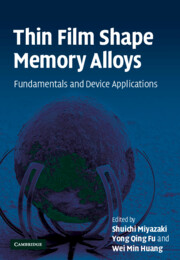Book contents
- Frontmatter
- Contents
- List of contributors
- Preface
- Abstracts of chapters
- 1 Overview of sputter-deposited TiNi based thin films
- 2 Martensitic transformation in TiNi alloys
- 3 Deposition techniques for TiNi thin film
- 4 TiNi multilayer thin films
- 5 Crystallization and microstructural development
- 6 Mechanical properties of TiNi thin films
- 7 Stress and surface morphology evolution
- 8 Ion implantation processing and associated irradiation effects
- 9 Laser post-annealing and theory
- 10 Overview of thin film shape memory alloy applications
- 11 Theory of SMA thin films for microactuators and micropumps
- 12 Binary and ternary alloy film diaphragm microactuators
- 13 TiNi thin film devices
- 14 Shape memory microvalves
- 15 Superelastic thin films and applications for medical devices
- 16 Fabrication and characterization of sputter-deposited TiNi superelastic microtubes
- 17 Thin film shape memory microcage for biological applications
- 18 Shape memory thin film composite microactuators
- 19 TiNi thin film shape memory alloys for optical sensing applications
- Index
5 - Crystallization and microstructural development
Published online by Cambridge University Press: 23 February 2010
- Frontmatter
- Contents
- List of contributors
- Preface
- Abstracts of chapters
- 1 Overview of sputter-deposited TiNi based thin films
- 2 Martensitic transformation in TiNi alloys
- 3 Deposition techniques for TiNi thin film
- 4 TiNi multilayer thin films
- 5 Crystallization and microstructural development
- 6 Mechanical properties of TiNi thin films
- 7 Stress and surface morphology evolution
- 8 Ion implantation processing and associated irradiation effects
- 9 Laser post-annealing and theory
- 10 Overview of thin film shape memory alloy applications
- 11 Theory of SMA thin films for microactuators and micropumps
- 12 Binary and ternary alloy film diaphragm microactuators
- 13 TiNi thin film devices
- 14 Shape memory microvalves
- 15 Superelastic thin films and applications for medical devices
- 16 Fabrication and characterization of sputter-deposited TiNi superelastic microtubes
- 17 Thin film shape memory microcage for biological applications
- 18 Shape memory thin film composite microactuators
- 19 TiNi thin film shape memory alloys for optical sensing applications
- Index
Summary
Abstract
This chapter focuses on the crystallization of TiNi shape memory alloy thin films. These materials are commonly sputter-deposited in an amorphous form and require high-temperature thermal treatments to create their crystalline (actuating) form. The microstructures that emerge during crystallization depend on the nucleation and growth kinetics. This chapter briefly surveys crystallization theory and methods to determine these kinetic parameters such as calorimetry, X-ray diffraction and microscopy. Novel microscopy methods have also been developed to provide a robust description that can give rise to the prediction of microstructures. In addition to presenting these tools, this chapter will also survey various factors that influence crystallization and microstructural development, which include annealing temperature, composition, substrate materials and film thickness.
Introduction
The crystallization of nickel-titanium thin films is of important scientific concern since the as-deposited form of these films is commonly amorphous and requires a high-temperature annealing step to create their crystalline form. It is well-known that the resulting microstructures dictate the phase transformation behavior of these unique materials [1]. As such, an understanding of the structure–property link can give rise to the development of more reliable devices based on them [1, 2]. Unlike the melting of materials, crystallization does not occur at a unique temperature, but hinges on both temperature and time. For TiNi thin films, the general rule of thumb for crystallization is an annealing step near 500 °C for one hour [3, 4]. However, there is a wide range of processing conditions in the literature from very high temperatures to no annealing at all. Such an assortment in processing conditions produces different films.
- Type
- Chapter
- Information
- Thin Film Shape Memory AlloysFundamentals and Device Applications, pp. 124 - 144Publisher: Cambridge University PressPrint publication year: 2009
- 2
- Cited by

